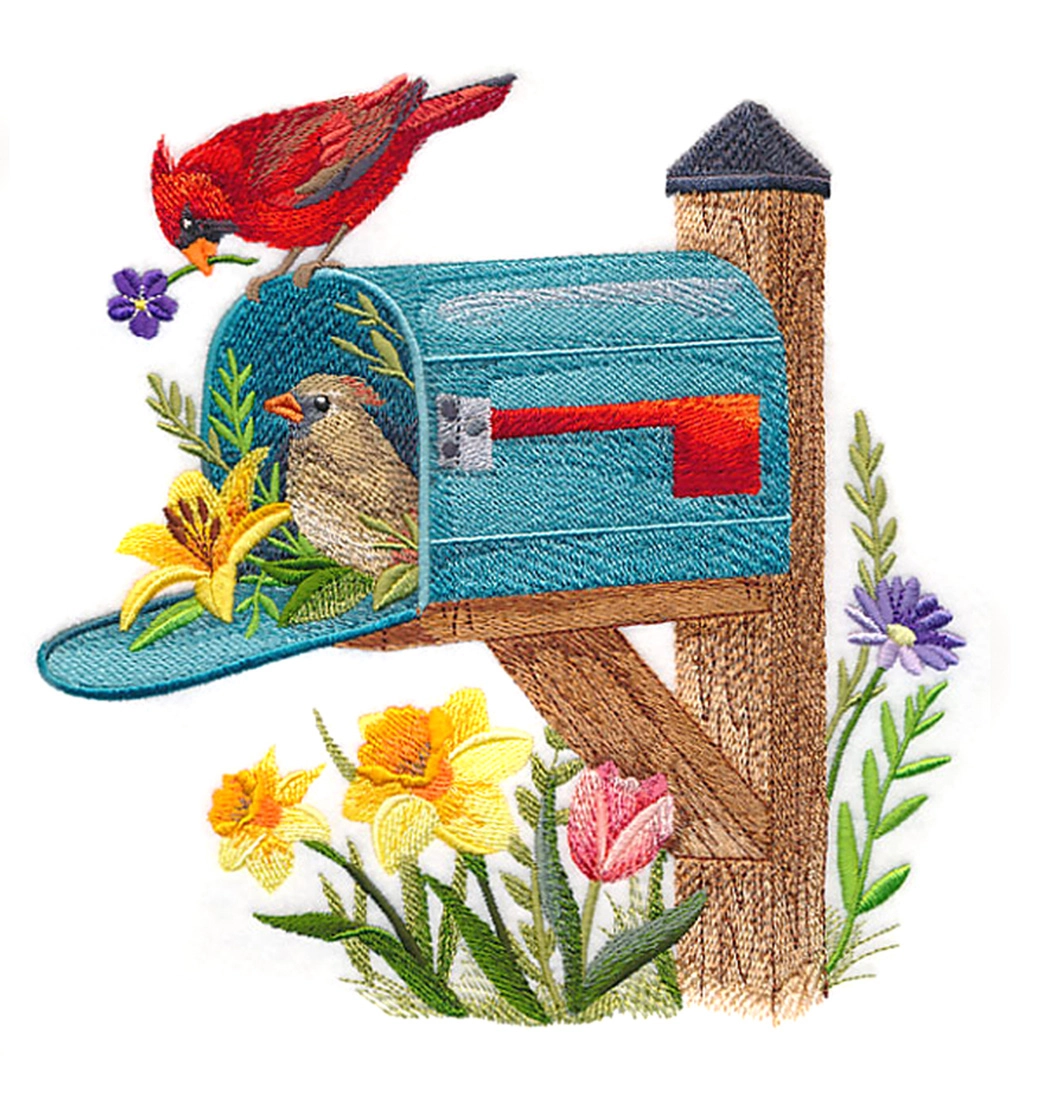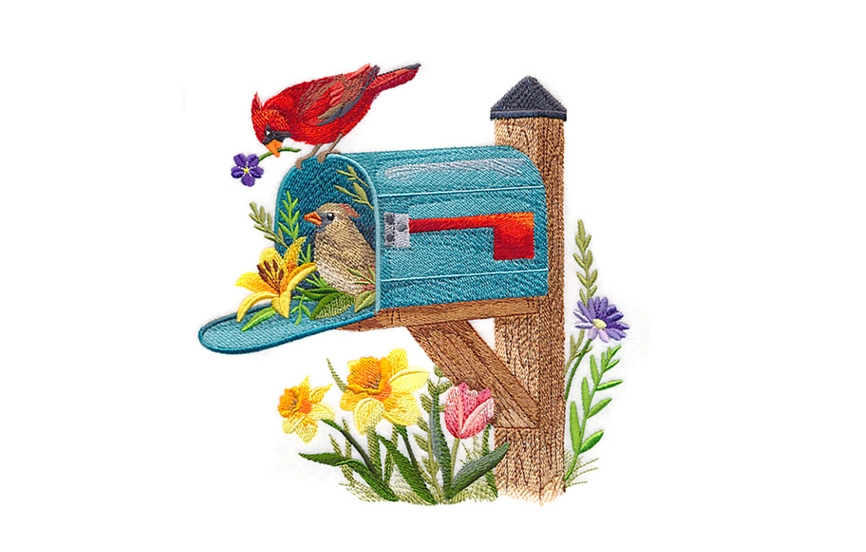October's installment of the Placemat of the Month series is here! Take a trip to the far east with unique and graceful Asian-themed placemats.
Kenny used embroidery designs inspired by the ancient art of East Asian ink wash painting, also known as sumi-e, which means "black ink painting." Pair the elegance of these designs with lotus flower quilt blocks to create a worldly placemat that will delight at your next gathering.
Read below for these free project instructions and bring the beauty of Asian art into you home today!
October's Taste of Asia Placemat is the tenth installment of the Placemat of the Month series. Check back the first Wednesday of each month and you'll find a new placemat project, absolutely free for your use! Each project will demonstrate how to combine your love of embroidery with classic quilting methods.
Have you missed an installment? Links are below!
January - Snowball Block Placemat
February - Lots of Love Placemat
March - Patchwork Placemat & Patchwork Table Runner
April - Spring Pinwheel Placemat
May - Sunflower Fiesta Placemat
June - Summertime Trapunto Placemat & Summertime Trapunto Table Runner
July - Crafty Cravings Placemat
August - Puppy Love Placemat
September - Autumn Abundance Placemat & Autumn Abundance Table Runner
November - Give Thanks Pocket Placemat
December - Rudolph's Run Placemat & Rudolph's Run Table Runner
Supplies
Supplies Needed:
**1/2 yard solid-colored quilter's cotton (for borders and back)
**1/4 yard solid-colored quilter's cotton (for embroidered blocks)
**4 fat quarters (in four different colors -- for block borders)
**Small pieces of print quilter's cotton (for lotus blocks and borders)
**Batting or extra-loft batting
**Medium-weight cutaway stabilizer
**Temporary spray adhesive
**Air-erase pen (or other marking tool)
**Straight edge
**Quilting cutting mat
**Rotary cutter
**Nylon monofilament thread
**Needle and thread for some hand sewing
Designs used:
Sumi-e Butterfly - Small
Sumi-e Willow - Small
Sumi-e Lily - Small
These designs are also available in design packs:
A Brushstroke Beauties Design Pack - Large, Medium, Small
Asian art embroidery designs have been among the most popular at Embroidery Library and there are lots of fabulous designs to choose from! Use the Brushstroke Beauties Designs to make a placemat similar to the one shown in this project. Or, choose designs from another Asian art collection such as: Asian Watercolor Squares, Chinese butterflies, or cute Krafty Kokeshi designs.
Finished Size:
19 inches wide by 13 1/4 inches high
Designs Used
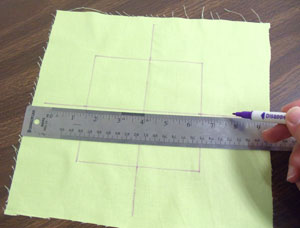
To begin, we will prepare the fabric for the embroidered blocks. Using an air-erase pen (or other marking tool), draw a 5 inch by 5 inch square on the solid colored fabric -- leave a couple of inches of excess fabric around the shape.
Measure and mark the center of each side of the square by measuring and dividing by two. Draw lines to connect the marks. Where the lines meet is the exact center of the shape.
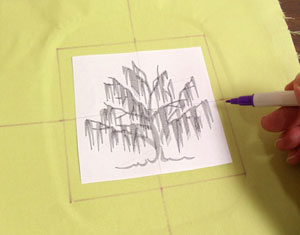
Create paper templates of the designs by printing them at full size using embroidery software. If you don't have embroidery software, you can cut pieces of paper to the shape and dimensions of the designs to help with placement and centering. If you'd like a recommendation for an embroidery program that can make templates, consider Embird from www.Embird.com.
Poke a hole in the center of the first design and align it with the center point on the fabric. Make sure the design fits well within the shape -- there should be at least 1/2 inch of space between the edges of the design and the edges of the shape.
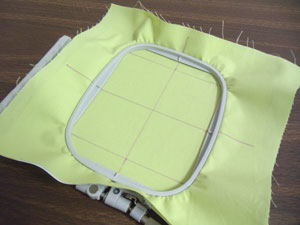
Remove the template and spray a piece of medium-weight cutaway stabilizer with temporary adhesive and smooth the fabric on top. Hoop the fabric and stabilizer together by aligning the marks on the hoop with the lines on the fabric. Attach the hoop to the machine and load the first design. Move the hoop so that the needle is directly over the center point on the fabric. Embroider the design.

When the design has finished, cut out the shape (we did not trim the stabilizer on the back of the embroidery).
Repeat the fabric marking, hooping, and embroidering process for each embroidered block (we are embroidering three blocks).
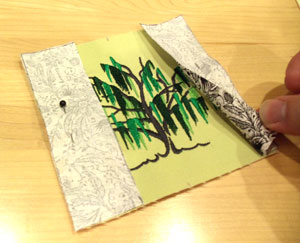
Now we will prepare the fabric for the borders of the embroidered blocks. For each block, cut two pieces of print cotton 1 1/2 inches wide by 5 inches high (for the sides), and two pieces 7 inches wide by 1 1/2 inches high (for the top and bottom).
Align the side pieces with the side edges of the embroidered square with right sides facing. Pin in place, and sew a 1/4 inch seam along the pinned edges only. We are using a "walking foot" attachment on our machine -- this helps prevent the layers of fabric from shifting as we sew. Press the back seams open with an iron.
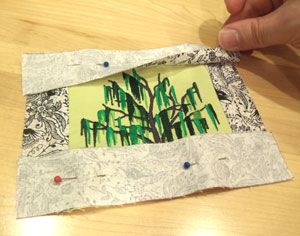
Align the top and bottom border pieces with the top and bottom edges of the block with right sides facing. Pin in place, sew a 1/4 inch seam along the pinned edges, and press the back seams.
Repeat this process for each embroidered block.
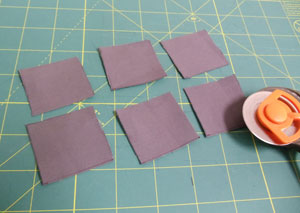
Next, we will prepare the fabric pieces for the lotus flower blocks.
For the background fabric, cut six squares 1 5/8 inches wide by 1 5/8 inches high.

Cut three squares 1 7/8 inches by 1 7/8 inches. Cut them in half diagonally (cut from one corner to the opposite corner), for a total of six triangle pieces.
Then, cut the following pieces for the flower (we used white fabric) and the leaf (we used yellow fabric):
-
Flower -- two squares 1 5/8 inches wide by 1 5/8 inches high. Also, two squares 1 7/8 inches wide by 1 7/8 inches high, cut in half diagonally.
-
Leaf -- two squares 1 5/8 inches wide by 1 5/8 inches wide. Also, one square 1 7/8 inches wide by 1 7/8 inches high, cut in half diagonally.
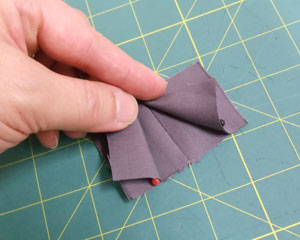
Next, we will assemble the lotus block row-by-row, starting with the top row.
Take four of the square background pieces and align two of them together with right sides facing. Pin in place, sew a 1/4 inch seam along one of the sides, and press the seams. Align each of the remaining squares with the outer raw edges of the assembled squares, with right sides facing. Pin in place, and sew a 1/4 inch seam along the pinned side edges.

Press the back seams open.

To assemble the second row (from the top), align one of the flower triangle pieces with one of the background triangle pieces, with right sides facing. Pin in place, and sew a 1/4 inch seam along the long angled edge. Press the seam.
Repeat this process for a total of two flower/background pieces.
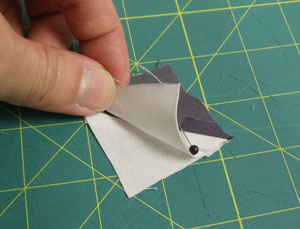
Align the two assembled pieces together with right sides facing, and the flower and background pieces aligned. Pin in place along the side with the background fabric and sew a 1/4 inch seam along the pinned edge. Press the seam.

Align two of the background squares with the raw edges of the assembled flower/background piece, with right sides facing. The colored flower edges should be at the bottom. Pin in place, sew a 1/4 inch seam along the pinned edges, and press the seams.
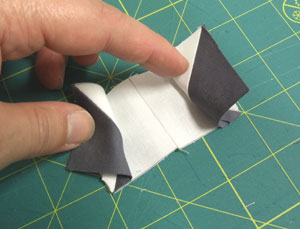
To assemble the third row (from the top), align two of the flower squares together with right sides facing. Pin in place, sew a 1/4 inch seam along one of the sides, and press the seams.
Assemble two finished squares using two of the flower triangle pieces and two of the background triangle pieces just as you did for the second row. Align the assembled pieces with the raw edges of the assembled flower squares, with right sides facing. One edge of the flower should align with the side raw edge and the other with the top raw edge. Pin in place, sew a 1/4 inch seam along the pinned side edges, and press the seams.
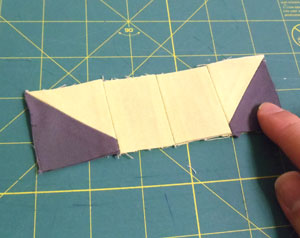
To assemble the bottom row, repeat the same process you used for the third row using the leaf pieces and the remaining background pieces.

Now that all the rows are complete, it is time to assemble the block. Place the top row on top of the second row with right sides facing. The bottom edge of the top row should be aligned with the top edge of the second row. Align the seams, pin in place, and sew a 1/4 inch seam along the top edge only. Press the seams.
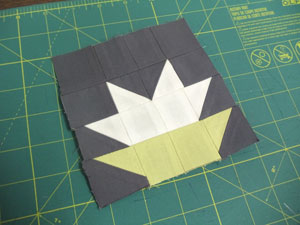
Repeat this process for the third row and the bottom row: Align the bottom edge of the previous row with the top edge of the next row, with right sides facing. Align the seams, pin in place, and sew a 1/4 inch seam along the pinned edge.
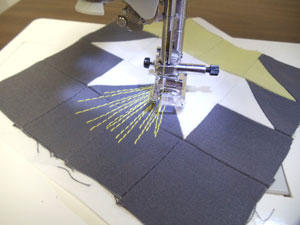
To add the flower detail, spray a piece of cutaway stabilizer with adhesive and smooth it on the back of the block. Using a straight stitch, sew lines up and down starting at the center "v" of the flower, leaving about 1/2 inch of space between the ends of the stitching and the top edge of the block. Trim away the excess stabilizer on the back of the block.

Add a border to each block just as you did for the embroidered blocks: For each block, cut two pieces of print cotton 1 1/2 inches wide by 5 inches high (for the sides) and two pieces 7 inches wide by 1 1/2 inches high (for the top and bottom).
Repeat the fabric cutting and sewing process for each lotus block (we made a total of three blocks).

Now that all of the blocks are assembled, it is time to assemble the front panel. Arrange the blocks how you want them to look.

Align the top left block with the bottom left block with right sides facing, and the seams aligned. Pin in place along the top edge. Sew a 1/4 inch seam along the pinned edge only and press the back seam.
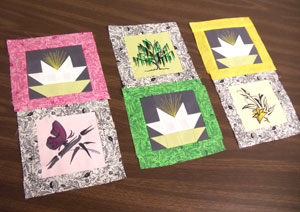
Repeat this process with the top and bottom center blocks and the top and bottom right blocks.
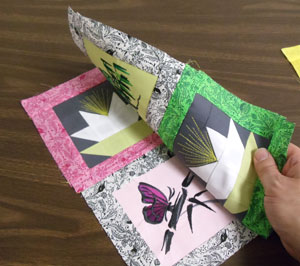
Lay the left blocks flat and align the center blocks on top with the right sides facing. Align the seams and pin in place along the right edge. Sew a 1/4 inch seam along the pinned edge only. Press the seams.

Align the right blocks on top of the center blocks with right sides facing and seams aligned. Pin in place, sew a 1/4 inch seam along the pinned edge, and press the seams.

To prepare the fabric for the side borders, cut two pieces of fabric 1 1/2 inches wide by 12 3/4 inches high. Align the side pieces with the side edges of the assembled front panel, with right sides facing. Pin in place, sew a 1/4 inch seam along the pinned edges, and press the seams.
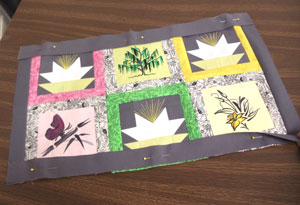
To prepare the fabric for the top and bottom borders, cut two pieces of fabric 20 inches wide by 1 1/2 inches high. Align the top and bottom pieces with the top and bottom edges of the assembled front panel, with right sides facing. Pin in place, sew a 1/4 inch seam along the pinned edges, and press the seams.

To prepare the fabric for the back of the placemat, lay the assembled front panel on top of the fabric, pin, and cut out the shape. Also, cut a piece of the batting just as you did for the back. Lay the batting flat and align the back panel on top with the right side facing up (wrong side faces batting). Align the front panel on top of the back panel with right sides facing (wrong side of front panel facing up), and pin all the layers in place. Sew a 1/4 inch seam along the top, bottom, and one side edge -- leave the other side edge open for turning.

Turn the placemat right side out between the front and back panels (the batting will end up inside the placemat), and press the seams. Also, turn the fabric of the opening in 1/4 inch and press.

Hand-sew the opening closed with a needle and thread.
With nylon monofilament in the needle and matching thread in the bobbin (thread that matches the back fabric) quilt through all the layers by stitching along the existing seams of the front panel -- we stitched around the inner edges of the outer border, and around the inner and outer edges of each block.

Now that your placemat is complete, stitch an entire set and enjoy a taste of Asia in your very own home!

